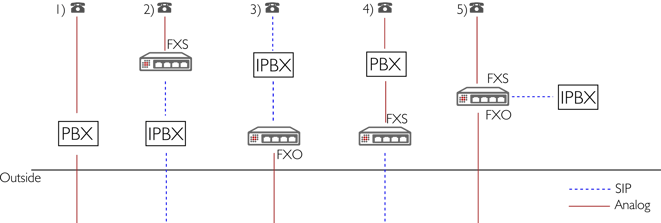When working in VoIP and telephony systems you will encounter a lot of acronyms. Even after you discover the words represented by the acronyms, it isn't always clear what they actually mean. Here are two simple guidelines that will help you distinguish the difference between FXO and FXS:
- If you want to connect your IPBX with your analog line, you need to use FXO. The gateway connects the IPBX to the Operator - FXO(perator) - and enables the end client to make calls via its former line;
- However, if you have analog endpoints like telephones, faxes or any other analog machine, you need FXS.
In the image above five scenarios are presented:
- A traditional analog PBX with analog endpoints connected to an analog line - a typical scenario still found in a lot of companies;
- We kept the existing analog endpoints and connected them to a new IPBX. To do so, a FXS gateway is necessary;
- An IPBX is connected to SIP telephones directly as they both speak the same language: SIP. However in order to connect the IPBX to an analog line, we use a FXO gateway;
- Here, we would like to keep the existing equipment: the PBX and the endpoints, and connect everything to a SIP line. In this case, the PBX is viewed as an endpoint for the gateway. Therefore a FXS gateway is necessary.
- To connect an IPBX to an analog line and an analog endpoint we need a gateway with FXO AND FXS technologies.




